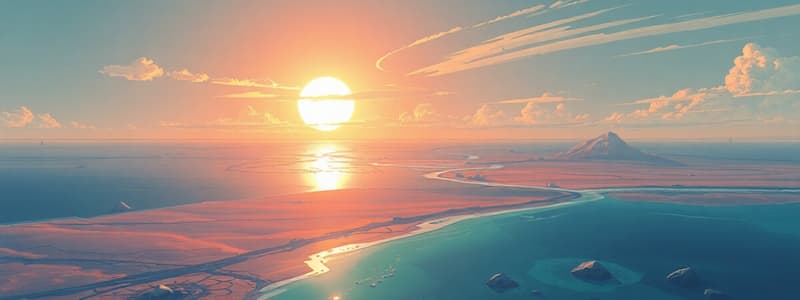Podcast
Questions and Answers
Where is the Aral Sea located?
Where is the Aral Sea located?
- Between Uzbekistan and Kazakhstan in Central Asia (correct)
- In South America
- Between Russia and China
- In Northern Africa
The Aral Sea is part of which desert?
The Aral Sea is part of which desert?
- Kalahari Desert
- Turkestan Desert (correct)
- Sahara Desert
- Gobi Desert
What is the primary source of water for the Aral Sea?
What is the primary source of water for the Aral Sea?
- The Nile River
- The Amazon River
- The Volga River
- The Amu Darya and Syr Darya Rivers (correct)
Which body of water was the fourth largest inland water body in 1960?
Which body of water was the fourth largest inland water body in 1960?
By 2007, what percentage of its original size had the Aral Sea shrunk to?
By 2007, what percentage of its original size had the Aral Sea shrunk to?
What contributed to the shrinking of the Aral Sea?
What contributed to the shrinking of the Aral Sea?
In the early 1960s, the Soviet Union diverted rivers to grow which crop?
In the early 1960s, the Soviet Union diverted rivers to grow which crop?
What has happened to the fishing industry in the Aral Sea?
What has happened to the fishing industry in the Aral Sea?
What negative effect do dust storms have on nearby towns?
What negative effect do dust storms have on nearby towns?
What has caused the destruction of the Aral Sea?
What has caused the destruction of the Aral Sea?
What lake in Africa has nearly disappeared for the same reasons as the Aral Sea?
What lake in Africa has nearly disappeared for the same reasons as the Aral Sea?
What happened to the wetlands of the two river deltas near the Aral Sea?
What happened to the wetlands of the two river deltas near the Aral Sea?
Why is the regional climate drier around the Aral Sea?
Why is the regional climate drier around the Aral Sea?
When did some lake restoration work begin on the northern part of the Aral Sea?
When did some lake restoration work begin on the northern part of the Aral Sea?
What has happened to the salinity of the Aral Sea?
What has happened to the salinity of the Aral Sea?
Flashcards
What is the Aral Sea?
What is the Aral Sea?
A lake located east of the Caspian Sea, between Uzbekistan and Kazakhstan in Central Asia.
What is the Turkestan Desert?
What is the Turkestan Desert?
The fourth largest desert in the world where the Aral Sea is.
What causes Turkestan's rain shadow?
What causes Turkestan's rain shadow?
Afghanistan's high mountains to the south.
What rivers supply the Aral Sea?
What rivers supply the Aral Sea?
Signup and view all the flashcards
Why did the Soviets divert rivers?
Why did the Soviets divert rivers?
Signup and view all the flashcards
Which country is a large cotton exporter?
Which country is a large cotton exporter?
Signup and view all the flashcards
What impact did diversion have on the Aral Sea?
What impact did diversion have on the Aral Sea?
Signup and view all the flashcards
What lakes were larger than the Aral Sea in 1960?
What lakes were larger than the Aral Sea in 1960?
Signup and view all the flashcards
How much did the Aral Sea shrink by 2007?
How much did the Aral Sea shrink by 2007?
Signup and view all the flashcards
How did salinity change in the Aral Sea?
How did salinity change in the Aral Sea?
Signup and view all the flashcards
What was the environmental impact of the Aral Sea shrinkage?
What was the environmental impact of the Aral Sea shrinkage?
Signup and view all the flashcards
What was wrong with the irrigation canals?
What was wrong with the irrigation canals?
Signup and view all the flashcards
What are the health consequences around the Aral Sea?
What are the health consequences around the Aral Sea?
Signup and view all the flashcards
How did the climate change around the Aral Sea?
How did the climate change around the Aral Sea?
Signup and view all the flashcards
What caused the Aral Sea's destruction?
What caused the Aral Sea's destruction?
Signup and view all the flashcards
Study Notes
Overview of the Aral Sea
- The Aral Sea is located east of the Caspian Sea between Uzbekistan and Kazakhstan in Central Asia.
- It lies within the Turkestan desert, the world's fourth largest desert, formed by Afghanistan's mountains creating a rain shadow.
- The climate is arid and seasonally hot, leading to significant evaporation.
- Summer temperatures can reach up to 60°C (140°F).
- The primary water sources were the Amu Darya and Syr Darya rivers, fed by snowmelt from mountainous regions.
Diversion of Rivers
- In the early 1960s, the Soviet Union diverted the Amu Darya and Syr Darya rivers to irrigate dry areas for the production of rice, melons, cereals, and especially cotton.
- The Soviets aimed to make cotton a major export.
- Uzbekistan is now one of the world's largest cotton exporters.
- The diversion essentially stopped river inflow to the Aral Sea, leading to its near disappearance.
Shrinking of the Aral Sea
- In 1960, the Aral Sea was the fourth largest inland water body, after the Caspian Sea, Lake Superior, and Lake Victoria.
- It has shrunk progressively due to evaporation and lack of river recharge.
- Before 1965, it received 2060 km³ of fresh water annually, but by the early 1980s, this ceased.
- By 2007, the Aral Sea had shrunk to about 10% of its original size.
Environmental Impact
- Salinity increased from about 1% to 10% dissolved salt, making it three times saltier than seawater.
- The once-thriving fishing industry collapsed, and 24 fish species could not adapt to the increased salinity and died.
- Shorelines are now tens of kilometers away from former fishing towns and ports, with fishing boats stranded in dried-up lakebeds.
- Irrigation canals were poorly constructed, leading to water leakage and evaporation.
- An increasing number of dust storms carry salt, pesticides, and herbicides into nearby towns, causing respiratory illnesses, including tuberculosis.
Consequences and Restoration Efforts
- Wetlands of the river deltas and associated ecosystems have disappeared.
- The regional climate became drier with greater temperature extremes because of the reduced moisture.
- In 2003, restoration work began in the northern part of the Aral Sea, raising water levels and reducing salinity.
- The southern part has not seen any relief and remains nearly completely dry.
- The destruction of the Aral Sea is considered one of the planet’s biggest environmental disasters, caused entirely by humans.
- Other lakes affected: Lake Chad, the Dead Sea, Lake Manchar, and Owens and Mono Lakes.
Studying That Suits You
Use AI to generate personalized quizzes and flashcards to suit your learning preferences.




